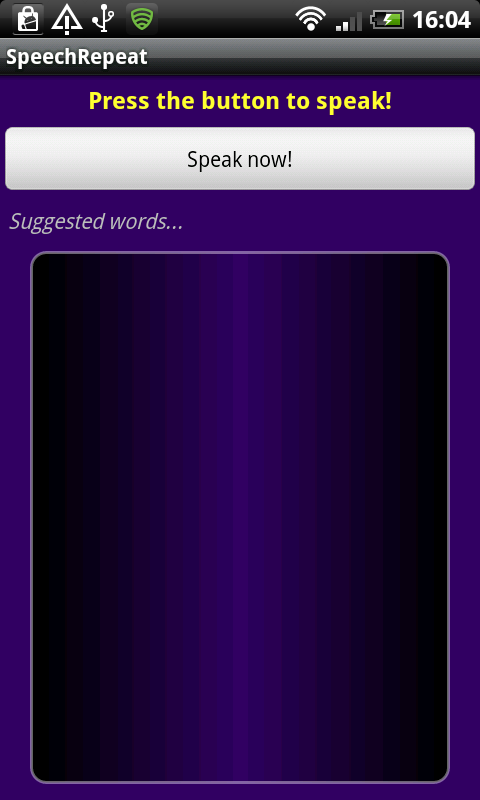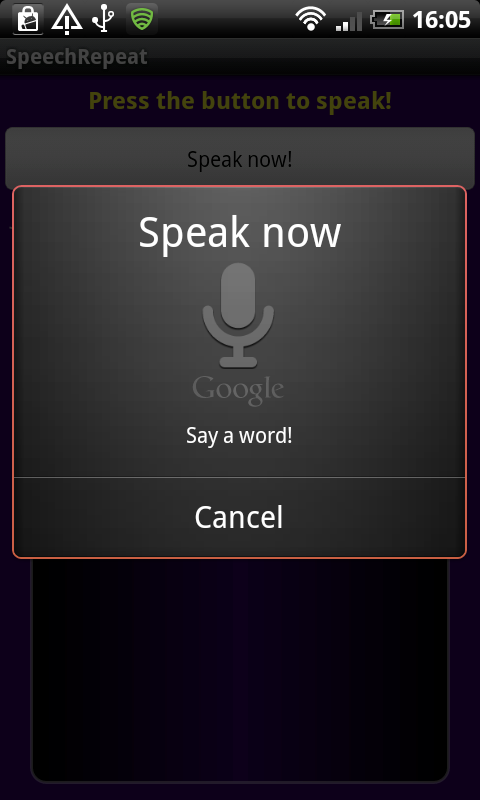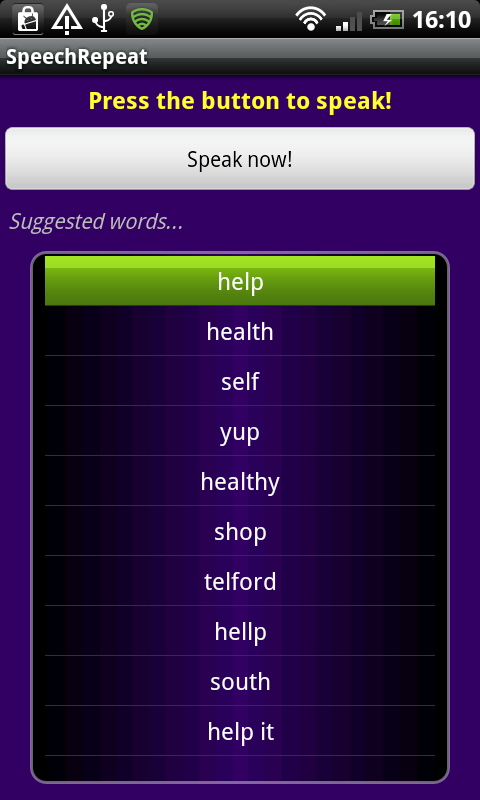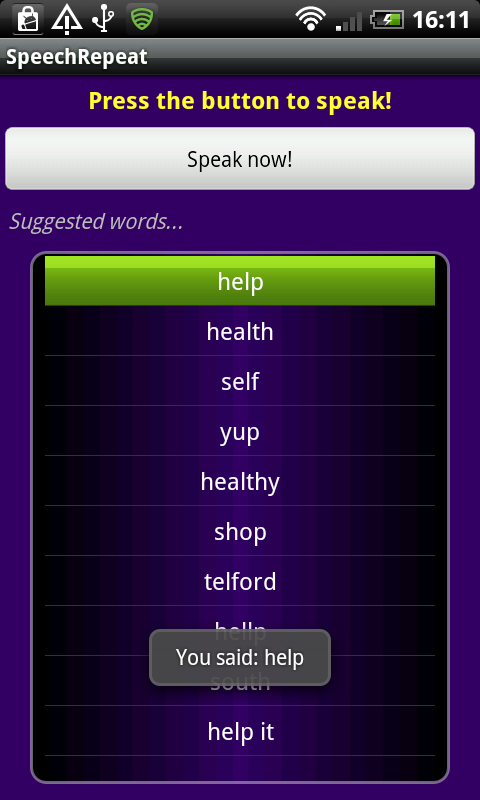The Android platform provides support for both speech recognition and
speech synthesis. In this tutorial, we will create a simple Android app
which allows the user to speak, attempts to recognize what they say,
and then repeats what was recognized back to them using the Text To
Speech engine.
The app is going to use a few text Strings as part of the interface, so define them by opening the “res/values/strings.xml” file and entering the following content:
Of course, you can alter the String content in any way you like.
Open your “res/layout/main.xml” file to create the main app layout. Switch to the XML editor if the graphical editor is displayed by default. Enter a Linear Layout as the main layout for the app’s launch Activity:
The
Linear Layout contains various style declarations including a
background color. Inside the Linear Layout, first enter an informative
Text View:
Notice
that the Text View refers to one of the Strings we defined. It also
sets various display properties which you can alter if you wish. After
the Text View, add a button:
The
user will press this button in order to speak. We give the button an ID
so that we can identify it in the Java code and display one of the
Strings we defined on it. After the button, add another informative Text
View, which will precede the list of suggested words:
Again,
this Text View uses a String resource and contains style properties.
The last item in our main.xml Linear Layout is the list of suggested
words:
The
List View will be populated with data when the app runs, so we give it
an ID for identification in Java. The element also refers to a drawable
resource, which you should add to each of the drawables folders in your
app’s “res” directory, saving it as “words_bg.xml” and entering the
following content:
This
is a simple shape drawable to display behind the List View. You can of
course alter this and the List View style properties if you wish. The
only remaining user interface item we need to define now is the layout
for a single item within the list, each of which will display a word
suggestion. Create a new file in “res/layout” named “word.xml”and then
enter the following code:
Each
item in the list will be a simple Text View. That’s our interface
design complete. This is how the app appears on initial launch:
 Note:
don’t worry about the lack of dithering, this is just how it looks in
the DDMS screenshot. On the device itself, the gradient is perfectly
smooth.
Note:
don’t worry about the lack of dithering, this is just how it looks in
the DDMS screenshot. On the device itself, the gradient is perfectly
smooth.
You
may not need all of these if you do not implement the TTS functionality
– Eclipse should highlight imports you have not used so check them when
you finish coding. Extend your opening class declaration line as
follows, altering the Activity name to suit your own:
The
“OnInitListener” is only required for the TTS function. Add the
following instance variables inside your class declaration, before the
“onCreate” method:
Inside
your “onCreate” method, your class should already be calling the
superclass method and setting your main layout. If not, it should begin
like this:
Next, still inside your “onCreate” method, retrieve a reference to the speech button and list we created, using their ID values:
The
List View is an instance variable, accessible throughout the class. Now
we need to find out whether the user device has speech recognition
support:
We
query the environment to see if the Recognizer Intent is present. If it
is, we instruct the app to listen for the user pressing the speech
button. If speech recognition is not supported, we simply disable the
button and output an informative message to the user.
Now implement the method we’ve called here after the “onClick” method:
Some
of this code is standard for setting up the speech recognition
listening functionality. Areas to pay particular attention to include
the line in which we specify the “EXTRA_PROMPT” – you can alter this to
include text you want to appear for prompting the user to speak. Also
notice the “EXTRA_MAX_RESULTS” line, in which we specify how many
suggestions we want the recognizer to return when the user speaks. Since
we are calling the “startActivityForResult” method, we will handle the
recognizer results in the “onActivityResult” method.
When the app is listening for user speech, it will appear as follows:

Here
we retrieve the result of the speech recognition process. Notice that
the “if” statement checks to see if the request code is the variable we
passed when calling “startActivityForResult”, in which case we know this
method is being called as a result of the listening Intent. The
recognizer returns the list of 10 suggested words, which we store as an
Array List. We then populate the List View with these words, by setting
an Array Adapter object as Adapter for the View. Now each of the items
in the List View will display one of the suggested words.
If the app successfully recognizes the user input speech and returns the list of words, it will appear as follows:
 Alternatively, if the app does not recognize the user speech input, the following screen will appear:
Alternatively, if the app does not recognize the user speech input, the following screen will appear:

We
use the “setOnItemClickListener” method to assign a listener to each
item in the list. Inside the new “OnItemClickListener”, we implement the
“onItemClick” method to respond to these clicks – this method will fire
when the user selects a suggested word from the list. First, we cast
the View that has been clicked to a Text View, then we retrieve the text
from it. This text is the word the user has selected. We write the
chosen word out to the Log for testing and output it back to the user as
a Toast message. Depending on the needs of your own application, you
may wish to carry out further processing on the chosen word – this code
is purely for demonstration.
The user can press the touchscreen or use a trackball to select words in the list.
 When the user selects a word, the Toast message appears confirming it.
When the user selects a word, the Toast message appears confirming it.

Like
the speech listening process, we will receive the result of this code
checking for TTS data in the “onActivityResult” method. In that method,
before the line in which we call the superclass “onActivityResult”
method, add the following:
Here
we initialize the TTS if the data is already installed, otherwise we
prompt the user to install it. For additional guidance on using the TTS
engine, see the Android SDK: Using the Text to Speech Engine tutorial.
To complete TTS setup, add the “onInit” method to your class declaration, handling initialization of the TTS as follows:
Here we simply set the Locale for the TTS, but you can carry out other setup tasks if you like.
This
will cause the app to repeat the user’s chosen word as part of a simple
phrase. This will occur at the same time the Toast message appears.
Step 1: Start an Android Project
Create a new Android project in Eclipse. Alternatively, if you want to implement the speech recognition functionality in an existing app, open it instead. For this tutorial we have a minimum SDK version of 8, and you do not need to make any particular additions to your Manifest file, the default contents should suffice.Step 2: Define the User Interface
Let’s start by defining the user interface. When the app launches, the user will be presented with a button. On pressing the button, the app will prompt them to speak, listening for their voice input. When the speech recognition utility processes the speech input, the app will present a list of suggested words to the user. As you’ll know if you’ve tried speech recognition as a user, the recognizer is not always accurate, so this list is essential. When the user selects an item from the list, the app will speak it back to them using the TTS engine. The TTS part of the application is optional, so you can omit it if you prefer.The app is going to use a few text Strings as part of the interface, so define them by opening the “res/values/strings.xml” file and entering the following content:
1
2
3
4
5
6
| <resources> <string name="intro">Press the button to speak!</string> <string name="app_name">SpeechRepeat</string> <string name="speech">Speak now!</string> <string name="word_intro">Suggested words…</string></resources> |
Open your “res/layout/main.xml” file to create the main app layout. Switch to the XML editor if the graphical editor is displayed by default. Enter a Linear Layout as the main layout for the app’s launch Activity:
1
2
3
4
5
6
7
| android:layout_width="fill_parent" android:layout_height="fill_parent" android:orientation="vertical" android:background="#ff330066" android:paddingBottom="5dp" ></LinearLayout> |
1
2
3
4
5
6
7
8
| <TextView android:layout_width="fill_parent" android:layout_height="wrap_content" android:text="@string/intro" android:padding="5dp" android:textStyle="bold" android:textSize="16dp" android:gravity="center" android:textColor="#ffffff33" /> |
1
2
3
4
| <Button android:id="@+id/speech_btn" android:layout_width="match_parent" android:layout_height="wrap_content" android:text="@string/speech" /> |
1
2
3
4
5
| <TextView android:layout_width="fill_parent" android:layout_height="wrap_content" android:padding="5dp" android:text="@string/word_intro" android:textStyle="italic" /> |
1
2
3
4
5
6
7
8
9
10
11
12
13
| <ListView android:id="@+id/word_list" android:layout_width="fill_parent" android:layout_height="0dip" android:layout_weight="1" android:paddingLeft="10dp" android:paddingTop="3dp" android:paddingRight="10dp" android:paddingBottom="3dp" android:layout_marginLeft="20dp" android:layout_marginRight="20dp" android:layout_marginTop="5dp" android:layout_marginBottom="5dp" android:background="@drawable/words_bg" /> |
1
2
3
4
5
6
7
8
9
10
11
12
| android:dither="true"> <gradient android:startColor="#ff000000" android:endColor="#ff000000" android:centerColor="#00000000" android:angle="180" /> <corners android:radius="10dp" /> <stroke android:width="2dp" android:color="#66ffffff" /></shape> |
1
2
3
4
5
6
7
8
| android:layout_width="fill_parent" android:layout_height="fill_parent" android:gravity="center" android:padding="5dp" android:textColor="#ffffffff" android:textSize="16dp" ></TextView> |

Step 3: Setup Speech Recognition
Now we can implement our Java code. Open your app’s main Activity and add the following import statements at the top:
1
2
3
4
5
6
7
8
9
10
11
12
13
14
15
16
17
18
19
20
21
| import java.util.ArrayList;import java.util.List;import java.util.Locale;import android.app.Activity;import android.content.Intent;import android.content.pm.PackageManager;import android.content.pm.ResolveInfo;import android.os.Bundle;import android.speech.RecognizerIntent;import android.speech.tts.TextToSpeech.OnInitListener;import android.speech.tts.TextToSpeech;import android.util.Log;import android.view.View;import android.view.View.OnClickListener;import android.widget.AdapterView;import android.widget.AdapterView.OnItemClickListener;import android.widget.ArrayAdapter;import android.widget.Button;import android.widget.ListView;import android.widget.Toast;import android.widget.TextView; |
1
| public class SpeechRepeatActivity extends Activity implements OnClickListener, OnInitListener { |
1
2
3
4
5
6
7
8
9
10
11
12
| //voice recognition and general variables//variable for checking Voice Recognition support on user deviceprivate static final int VR_REQUEST = 999;//ListView for displaying suggested wordsprivate ListView wordList;//Log tag for output informationprivate final String LOG_TAG = "SpeechRepeatActivity";//***enter your own tag here***//TTS variables//variable for checking TTS engine data on user deviceprivate int MY_DATA_CHECK_CODE = 0;//Text To Speech instanceprivate TextToSpeech repeatTTS; |
1
2
3
4
| //call superclasssuper.onCreate(savedInstanceState);//set content viewsetContentView(R.layout.main); |
1
2
3
4
| //gain reference to speak buttonButton speechBtn = (Button) findViewById(R.id.speech_btn);//gain reference to word listwordList = (ListView) findViewById(R.id.word_list); |
1
2
3
4
5
6
7
8
9
10
11
12
13
| //find out whether speech recognition is supportedPackageManager packManager = getPackageManager();List<ResolveInfo> intActivities = packManager.queryIntentActivities(new Intent(RecognizerIntent.ACTION_RECOGNIZE_SPEECH), 0);if (intActivities.size() != 0) { //speech recognition is supported - detect user button clicks speechBtn.setOnClickListener(this);}else{ //speech recognition not supported, disable button and output message speechBtn.setEnabled(false); Toast.makeText(this, "Oops - Speech recognition not supported!", Toast.LENGTH_LONG).show();} |
Step 4: Listen for Speech Input
Let’s setup the click listener for the speech button we’ve instructed the app to detect clicks for. Outside the “onCreate” method, but inside your Activity class declaration, add an “onClick” method as follows:
1
2
3
4
5
6
7
8
9
| /** * Called when the user presses the speak button */public void onClick(View v) { if (v.getId() == R.id.speech_btn) { //listen for results listenToSpeech(); }} |
1
2
3
4
5
6
7
8
9
10
11
12
13
14
15
16
17
| /** * Instruct the app to listen for user speech input */private void listenToSpeech() { //start the speech recognition intent passing required data Intent listenIntent = new Intent(RecognizerIntent.ACTION_RECOGNIZE_SPEECH); //indicate package listenIntent.putExtra(RecognizerIntent.EXTRA_CALLING_PACKAGE, getClass().getPackage().getName()); //message to display while listening listenIntent.putExtra(RecognizerIntent.EXTRA_PROMPT, "Say a word!"); //set speech model listenIntent.putExtra(RecognizerIntent.EXTRA_LANGUAGE_MODEL, RecognizerIntent.LANGUAGE_MODEL_FREE_FORM); //specify number of results to retrieve listenIntent.putExtra(RecognizerIntent.EXTRA_MAX_RESULTS, 10); //start listening startActivityForResult(listenIntent, VR_REQUEST);} |
When the app is listening for user speech, it will appear as follows:

Step 5: Present Word Suggestions
Implement the “onActivityResult” method inside your class declaration as follows:
1
2
3
4
5
6
7
8
9
10
11
12
13
14
15
16
17
18
19
| /** * onActivityResults handles: * - retrieving results of speech recognition listening * - retrieving result of TTS data check */@Overrideprotected void onActivityResult(int requestCode, int resultCode, Intent data) { //check speech recognition result if (requestCode == VR_REQUEST && resultCode == RESULT_OK) { //store the returned word list as an ArrayList ArrayList<String> suggestedWords = data.getStringArrayListExtra(RecognizerIntent.EXTRA_RESULTS); //set the retrieved list to display in the ListView using an ArrayAdapter wordList.setAdapter(new ArrayAdapter<String> (this, R.layout.word, suggestedWords)); } //tss code here //call superclass method super.onActivityResult(requestCode, resultCode, data);} |
If the app successfully recognizes the user input speech and returns the list of words, it will appear as follows:


Step 6: Detect User Word Choices
We want to detect the user selecting words from the list, so let’s implement a click listener for the list items. Back in your “onCreate” method, after the existing code, set the listener for each item in the list as follows:
1
2
3
4
5
6
7
8
9
10
11
12
13
14
15
| //detect user clicks of suggested wordswordList.setOnItemClickListener(new OnItemClickListener() { //click listener for items within list public void onItemClick(AdapterView<?> parent, View view, int position, long id) { //cast the view TextView wordView = (TextView)view; //retrieve the chosen word String wordChosen = (String) wordView.getText(); //output for debugging Log.v(LOG_TAG, "chosen: "+wordChosen); //output Toast message Toast.makeText(SpeechRepeatActivity.this, "You said: "+wordChosen, Toast.LENGTH_SHORT).show();//**alter for your Activity name*** }}); |
The user can press the touchscreen or use a trackball to select words in the list.


Step 7: Setup TTS Functionality
If you do not want to implement the Text To Speech functionality, you can stop now and test your app. We only require a little more processing to make our app repeat the user’s chosen word. First, to set up the TTS engine, add the following code to the section in your “onCreate” method where you queried the system for speech recognition support. Inside the “if” statement, after “speechBtn.setOnClickListener(this);”:
1
2
3
4
5
6
| //prepare the TTS to repeat chosen wordsIntent checkTTSIntent = new Intent();//check TTS datacheckTTSIntent.setAction(TextToSpeech.Engine.ACTION_CHECK_TTS_DATA);//start the checking Intent - will retrieve result in onActivityResultstartActivityForResult(checkTTSIntent, MY_DATA_CHECK_CODE); |
1
2
3
4
5
6
7
8
9
10
11
12
13
14
15
| //returned from TTS data checkif (requestCode == MY_DATA_CHECK_CODE){ //we have the data - create a TTS instance if (resultCode == TextToSpeech.Engine.CHECK_VOICE_DATA_PASS) repeatTTS = new TextToSpeech(this, this); //data not installed, prompt the user to install it else { //intent will take user to TTS download page in Google Play Intent installTTSIntent = new Intent(); installTTSIntent.setAction(TextToSpeech.Engine.ACTION_INSTALL_TTS_DATA); startActivity(installTTSIntent); }} |
To complete TTS setup, add the “onInit” method to your class declaration, handling initialization of the TTS as follows:
1
2
3
4
5
6
7
8
| /** * onInit fires when TTS initializes */public void onInit(int initStatus) { //if successful, set locale if (initStatus == TextToSpeech.SUCCESS) repeatTTS.setLanguage(Locale.UK);//***choose your own locale here***} |
Step 8: Repeat the User Choice
Finally, we can repeat the user’s chosen word. Back in your “onCreate” method, inside the “OnItemClickListener” “onItemClick” method, after the line in which we output a Toast message, add the following:
1
2
| //speak the word using the TTSrepeatTTS.speak("You said: "+wordChosen, TextToSpeech.QUEUE_FLUSH, null); |










 ), Pause (
), Pause ( ) and Stop (
) and Stop ( ).
).

